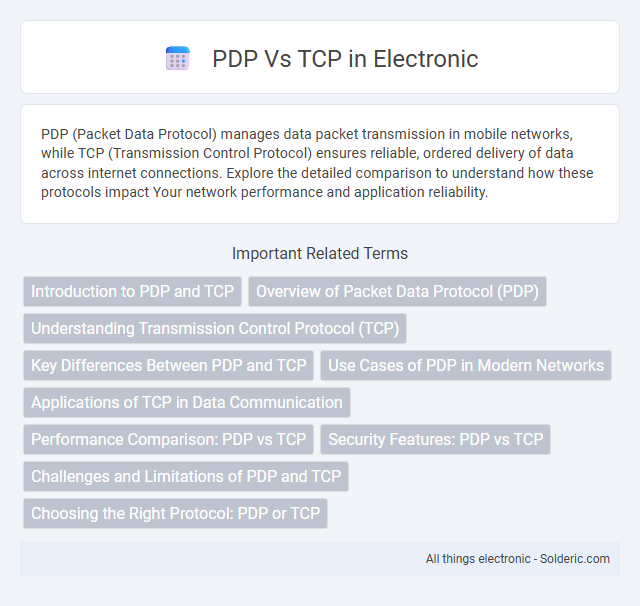PDP (Packet Data Protocol) manages data packet transmission in mobile networks, while TCP (Transmission Control Protocol) ensures reliable, ordered delivery of data across internet connections. Explore the detailed comparison to understand how these protocols impact Your network performance and application reliability.
Comparison Table
| Feature | PDP (Policy Decision Point) | TCP (Transmission Control Protocol) |
|---|---|---|
| Function | Central decision-making point in access control systems | Reliable, connection-oriented data transport protocol |
| Role | Evaluates access requests against policies | Manages data packet transmission between devices |
| Protocol Layer | Not a protocol; part of access control architecture | Transport Layer (Layer 4 of OSI model) |
| Reliability | Determines access control outcomes | Ensures reliable, ordered, and error-checked data delivery |
| Use Case | Authorization management in security frameworks | Internet data communication and file transfer |
| Example | XACML-based PDPs for policy enforcement | TCP used in HTTP, FTP, SMTP protocols |
Introduction to PDP and TCP
PDP (Packet Data Protocol) and TCP (Transmission Control Protocol) are fundamental components in mobile and internet communication networks. PDP defines the type of data packet and establishes a data session in cellular networks, enabling mobile devices to connect to packet-switched networks. TCP is a core transport layer protocol ensuring reliable, ordered, and error-checked delivery of data between applications across IP networks, making it essential for maintaining data integrity during transmission.
Overview of Packet Data Protocol (PDP)
Packet Data Protocol (PDP) enables mobile devices to establish a data session with a network, allowing IP packet transmission across cellular systems such as GPRS and LTE. It defines the parameters for data connectivity, including IP address assignment, Quality of Service (QoS) profiles, and access point selection. PDP context activation is essential for enabling internet access and multimedia services in 3G and 4G networks.
Understanding Transmission Control Protocol (TCP)
Transmission Control Protocol (TCP) ensures reliable, ordered delivery of data packets between devices in a network by establishing a connection-oriented communication channel. It manages data flow control, error detection, and retransmission to guarantee that Your information reaches its destination accurately and in sequence. TCP is essential for applications needing consistent data exchange, such as web browsing, email, and file transfers.
Key Differences Between PDP and TCP
PDP (Packet Data Protocol) manages data packet transmission in mobile networks, while TCP (Transmission Control Protocol) ensures reliable, ordered data delivery in IP networks. PDP defines session attributes such as IP address allocation and Quality of Service (QoS) for mobile devices, whereas TCP handles connection-oriented data flow control, error checking, and retransmission. The primary distinction lies in PDP's role within mobile packet data sessions versus TCP's function as a transport layer protocol enabling end-to-end communication.
Use Cases of PDP in Modern Networks
PDP (Packet Data Protocol) is crucial in modern mobile networks for establishing and managing data sessions, especially in 4G and 5G environments where seamless internet connectivity and IP address allocation are required. It enables devices to maintain active data connections during mobility, supporting use cases like video streaming, VoIP, and IoT sensor data transmission. Your mobile device relies on PDP contexts to manage and optimize data traffic efficiently across packet-switched networks, enhancing overall user experience.
Applications of TCP in Data Communication
TCP plays a critical role in data communication by ensuring reliable, ordered, and error-checked delivery of data between applications over IP networks. It is extensively used in web browsing (HTTP/HTTPS), email transmission (SMTP, IMAP, POP3), file transfers (FTP), and remote server access via protocols like SSH and Telnet. Your applications benefit from TCP's congestion control and flow control mechanisms, which maintain efficient and stable communication even in complex network environments.
Performance Comparison: PDP vs TCP
PDP (Packet Data Protocol) and TCP (Transmission Control Protocol) differ significantly in performance characteristics, affecting data transmission efficiency and reliability. PDP manages packet-switched data transfer primarily in mobile networks, offering optimized performance for variable bandwidth and latency conditions typical in cellular environments. Your choice between PDP and TCP impacts connection stability and speed, with TCP providing reliable, ordered delivery suitable for applications requiring accuracy, while PDP allows faster, flexible data sessions where lower overhead is beneficial.
Security Features: PDP vs TCP
PDP (Policy Decision Point) and TCP (Transmission Control Protocol) offer distinct security features tailored to their purposes in network management and communication. PDP centers on enforcing security policies, access control, and authorization decisions within network architectures, ensuring your data access complies with organizational rules. TCP provides robust security through mechanisms like sequence numbering and checksum validation to protect data integrity and prevent unauthorized data tampering during transmission.
Challenges and Limitations of PDP and TCP
PDP (Packet Data Protocol) faces challenges such as limited support for real-time data transmission, inefficient handling of dynamic IP addressing, and difficulty in managing packet loss in high-mobility environments. TCP (Transmission Control Protocol) encounters limitations including latency caused by its connection-oriented nature, overhead from error correction mechanisms, and reduced performance in high-bandwidth or high-latency networks due to congestion control algorithms. Both protocols struggle with scalability in rapidly changing network conditions and require optimization to improve reliability and speed in modern communication systems.
Choosing the Right Protocol: PDP or TCP
Choosing the right protocol depends on your application's requirements for speed and reliability. PDP (Packet Data Protocol) suits IP packet transfer in mobile networks, optimizing data sessions with low latency, while TCP (Transmission Control Protocol) ensures reliable, ordered delivery through connection-oriented communication, ideal for error-sensitive applications. Evaluating factors like network conditions, data integrity needs, and session management helps determine whether PDP's efficiency or TCP's robustness best supports your use case.
PDP vs TCP Infographic

 solderic.com
solderic.com